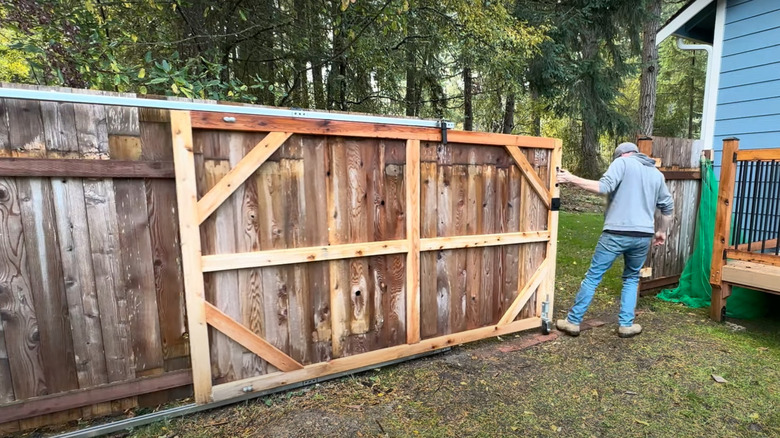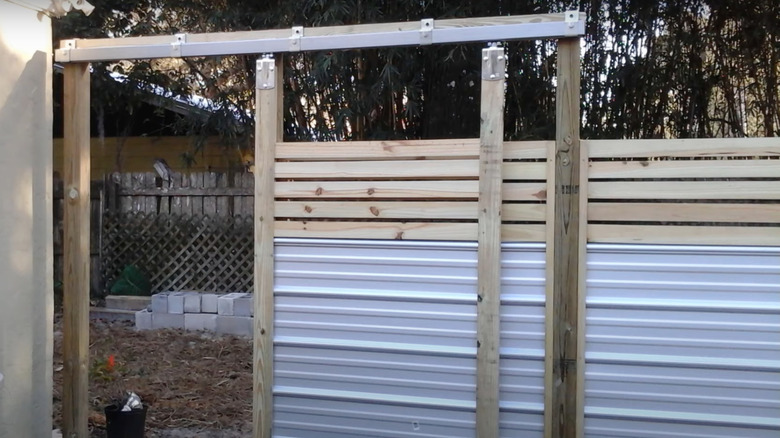Create A Horizontal Fence With A Barn Door For A Unique And Versatile Look
We may receive a commission on purchases made from links.
Installing a new fence is one of those backyard upgrades that are worth the extra cost. After all, your fence helps frame your yard, provides privacy, and creates an outdoor sanctuary for activities like dining al fresco, family reunions, or just playing with kids and pets. If you want your backyard fence to have a unique and versatile look, then a horizontal fence with a sliding barn door might be exactly what you're looking for. With traditional backyard gates, deciding if they should swing in or out is a major decision that impacts how usable your space is. With the sliding barn door gate, this worry is eliminated completely.
This style of sliding gate helps save space, increases security, and adds an aesthetic touch to your yard. It can be built using a variety of materials, including wood, vinyl, chain-link, metal, PVC, and composite, so customization options are excellent. While there are plenty of pre-built sliding gate kits on the market, you can easily DIY it with the right tools.
How to install a barn door on your horizontal fence
For the sliding hardware, grab two Galvanized Steel Sliding Barn Door Tracks, two Heavy Trolley Assembly Rollers, two Heavy-duty Gate Casters, and a drill that's suitable for drilling holes in metal. According to Catspaw Customs, you have to start by drilling three holes on each end of your sliding barn door tracks so that they can be easily attached to your existing fence. At this point, you can take one of your tracks and screw it to the bottom of your fence, ensuring that the open side faces up.
Now, to construct the door. For this, you will need four wooden boards, each with a half-lap joint — these boards will make the door frame. Glue three of the boards together at the joint to form a U-shape. Then, on both sides of your frame, drill three holes in the inner-facing center. Next, on a board that fits in the middle of your frame, drill three matching holes on either end and add wooden dowels. Using a combination of dowels and glue, attach this middle piece to the frame. Then you can glue down the final bottom board of your frame. Next, attach smaller, angle-cut boards to each corner of the frame with screws for reinforcement, then nail in as many vertical boards as you need to fill in the frame.
For the final steps, screw your trolley assembly rollers to the top ends of your door and attach the gate casters to the bottom. Slide your door caster-side down into the bottom track you installed earlier. Then, slide your top track into place and secure it to the fence with screws. Finally, attach a handle to the inner side of your door.
Potential downsides to the barn door fence
Despite all the benefits, there are a few disadvantages of installing barn doors on your horizontal fence that you need to look out for. For starters, these gates require more hardware than a swinging gate and therefore will cost more to install. Along the same lines, sliding gates will need regular maintenance to keep them in good working order. Things like clearing debris from the tracks and keeping the tracks lubricated is necessary if you want the gate to slide smoothly for a long time.
Another major factor to consider is the potential for user error. If you make a mistake during the installation process or opt for hardware that's not sturdy enough, your barn door gate can feel loose and wobbly, making it harder to use. You also need to consider the ease of opening. With swinging gates, you can use your hip to push the gate open when your hands are full of groceries. With a barn door, you will need a hand free to slide it open.


